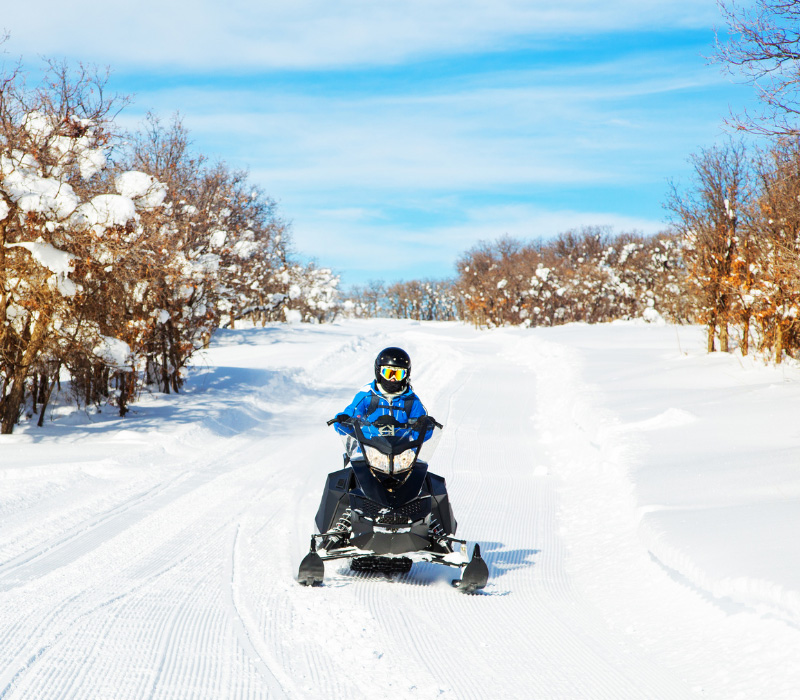In some snowmobile circles, the snowmobile season arguably never ends. Snowmobile enthusiasts are found shredding the slopes in specific areas throughout the year. However, in the United States, snowmobile trails are generally open from November through March of any given year, depending on the snow levels and temperatures.

Many anxious enthusiasts wait all year long for the temperatures to drop and for the snow to start falling so that they can begin prepping their snowmobiles for the start of another adrenaline-filled season. Far fewer know how to properly prep and store your snowmobile gear off-season for summer storage when the season ends.
Keep reading for a breakdown on how to store your snowmobile and snowmobile gear during the off-season properly. Let’s get started.
Clean the Frame
Before storing your snowmobile, you will want to clean your sled. A clean sled makes it easier to find cracks in the chassis, suspension, etc.; it also makes the remainder of the storage preparation much more manageable.

Start by removing the exhaust and then remove the belt. Then, tape off the intake to prevent any water from making its way into the sled’s engine.
After this is completed, your sled is ready to be cleaned. You can either take it through a self-serve car wash or pressure wash it with soap and water in your backyard.
Treat the fuel
The first step in properly preparing your snowmobile for storage is to treat your snowmobile's fuel. Experts usually recommend that instead of draining your fuel tank, you should leave it at least half fuel. Leaving your tank empty during summer storage can lead to your gaskets or O-rings drying out and becoming brittle. However, you must treat the gasoline with a fuel stabilizer.
If left untreated, the gas left in the tank will eventually evaporate or go stale. You can also run into even more severe issues if when the gas evaporates, the vapors rise from the fuel tank and cause the internal metals to corrode. You typically don't see this type of corrosion with fuel-injected engines as the throttle bottles are air-tight and impervious to the gas vapors.

To avoid all of these unwanted issues, you will need to treat the gasoline with a fuel stabilizer. Fuel stabilizers are typically made from petroleum products that bond with gas to prevent evaporation. Fuel stabilizers also provide a protective layer for the fuel sitting in the tank and make the gasoline less volatile.
After you pour the fuel stabilizer into the gasoline tank, slosh the mixture around in the tank. Next, start the engine. Leave your engine running for a few minutes. By doing this, you allow the treated fuel to flow through the fuel line and the fuel system.
Grease and Lubricate The Snowmobile
Liberally apply lightweight grease to any fittings and metal surfaces on the snowmobile, like the front and rear suspension, cylinder walls, and steering systems of your snowmobile.

Pump a few shots of grease into each zerk on the chassis to push out any water and fill the voids with grease. Continue to pump until you start to see fresh oil come out of the tube or shaft.
This process is relatively simple, but make sure you check your user’s manual for suitable snowmobile grease. You can also use any all-season lubricant. Avoid watercraft grease as it can cause your steering and suspension to stiffen during cold temperatures.
Fog the Snowmobile’s Engine
To prevent engine failure, coat the inside of your snowmobile’s engine with fogging oil. Fogging oil coats the inside of the engine and protects parts like the cylinder walls and crankshaft bearings from outside air and moisture. Without this coating, the water can lead to corrosion and weathering, leading to engine failure.

First, gain access to the carburetors or throttle bodies by removing the airbox. Next, spray the fogging oil into each of the intakes for a few seconds while the engine is running. Repeat with each cylinder until you are confident that all internal parts are oiled.
As an extra precaution, start your sled's engine every few weeks during the off-season to keep the fuel moving and your machine in good condition.
Park the Sled
Where and how you store your machine is ultimately up to you. However, where you park your sled will affect the longevity of your machine. Regardless of if you have the means or space to park your sled in a garage or shed, you will want to ensure that it is entirely away from the elements like water or humidity.
Preferably storage will be in a controlled environment. Ideally, park your sled in a dry indoor place and place a soft fitted cover on the sled to protect the body from dust, humidity, and scratches.

If you must store your sled outside, we recommend that you utilize a stand if you plan on keeping your snowmobile outside to avoid the moisture on the ground. This moisture can shorten the life of your snowmobile by causing the rubber and other materials to break down.
Relieve Spring Tension
If storing inside, put your snowmobile on sled dollies to prevent your carbides and runners from rusting. Sled dollies also prevent your machine from scratching your garage/shed floor. Place a jack stand under the rear bumper and then elevate the back end of your snowmobile.

Next, unhook the springs. Jacking the rear end of the sled and removing the springs enables the machine's suspension to relax by relieving the extra pressure on springs and taking the weight off the track lugs. Even though newer alloys hold their strength better, taking the tension off the spring will undoubtedly make the springs last longer.
Next, set the chassis onto a wood box or milk-crate so that the front suspension can hang freely. Although not necessary, if you have room in your budget, invest in a sled lift to keep your machine entirely off the ground for the duration of the off-season.
Keep Rodents Away
Unfortunately, snowmobiles make an excellent place for unwanted critters to thrive. Sprinkle mothballs under the hood of your sled to keep rodents away from your machine.
You should also never leave any type of food near your sled to avoid attracting any unwanted visitors. One other thing you can do is cover the exhaust and intake with either chicken wire or a small rubber ball to prevent dust or unwanted objects from making their way into your sled.
The last thing you want at the beginning of a season is to uncover your snowmobile and find that rodents have nested in the air box or chewed away at the foam seat covers of your machine.
Remove the Battery
After you are finishing cleaning and prepping your sled, experts recommend that you remove the machine's battery and store it in a safe, temperature-controlled place like a storage closet.
Next, attach the battery to either a battery tender or trickle charger of .5 amps or less to make your battery last for a few seasons. Batteries are expensive, so make sure you take care of them!
Store Snowmobile Gear Clothing
Keep all your winter gear, like boots, eVent Jackets, layering, bibs and everything else in one spot so that everything is easy to find when the snowmobile winter begins.
We also suggest cleaning rather than designating a specific closet in your home for snowmobile gear, many experts recommend storing winter items in an open space instead. In fact, you'll want to allow for as much air circulation as possible, since natural airflow will help snow-covered gear dry off more quickly and minimize the risk of unpleasant odors.

You can also attempt to clean all of your clothing, making sure they are completely dry before placing them in a storage tote. This way you can place them in a place out of sight, ready for your next rugged adventure.
Store Your Snowmobile Gear and Machines
With the correct storage preparations, your snowmobile will retain its value and extend its life considerably. Without it, you run the chance that your snowmobile won't start at the beginning of the next season.
It can also lead to broken parts and more money in the long run spent fixing the issues or replacing damaged snowmobiling gear.

Proper preparation and storage are imperative if you want your snowmobile to be in top-notch shape for the next season.
You have to take care of your snowmobile for it to run smoothly and take care of you out on the trails. Prioritize taking the time to store the snowmobile and clothing gear correctly.
Always follow your snowmobile user manual or consult a professional before and during making any maintenance updates to your machine. Feel free to contact our stellar team if you have any specific questions! Or if you are looking for some new gear for the next snowmobiling season, check out the lead innovator of snowmobiling gear, MOTORFIST.
